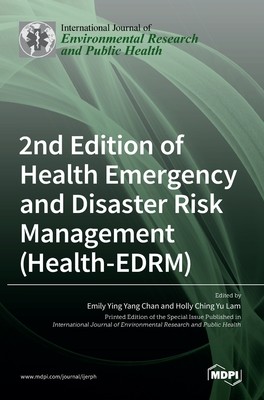
- We will send in 10–14 business days.
- Publisher: MDPI AG
- ISBN-10: 3036517502
- ISBN-13: 9783036517506
- Format: 17 x 24.4 x 2.2 cm, hardcover
- Language: English
- SAVE -10% with code: EXTRA
2nd Edition of Health Emergency and Disaster Risk Management (Health-EDRM) (e-book) (used book) | bookbook.eu
Reviews
Description
Disasters such as earthquakes, cyclones, floods, heat waves, nuclear accidents, and
large-scale pollution incidents take lives and incur major health problems. The majority
of large-scale disasters affect the most vulnerable populations, which often comprise
extreme ages, remote living areas, and endemic poverty, as well as people with low
literacy. Health emergency and disaster risk management (Health-EDRM) refers to the
systematic analysis and management of health risks surrounding emergencies and
disasters, and plays an important role in reducing the hazards and vulnerability along
with extending preparedness, responses, and recovery measures. This concept
encompasses risk analyses and interventions, such as accessible early warning systems,
the timely deployment of relief workers, and the provision of suitable drugs and medical
equipment to decrease the impact of disasters on people before, during, and after an
event (or events). Currently, there is a major gap in the scientific literature regarding
Health-EDRM to facilitate major global policies and initiatives for disaster risk reduction
worldwide.
EXTRA 10 % discount with code: EXTRA
The promotion ends in 17d.14:20:59
The discount code is valid when purchasing from 10 €. Discounts do not stack.
- Publisher: MDPI AG
- ISBN-10: 3036517502
- ISBN-13: 9783036517506
- Format: 17 x 24.4 x 2.2 cm, hardcover
- Language: English English
Disasters such as earthquakes, cyclones, floods, heat waves, nuclear accidents, and
large-scale pollution incidents take lives and incur major health problems. The majority
of large-scale disasters affect the most vulnerable populations, which often comprise
extreme ages, remote living areas, and endemic poverty, as well as people with low
literacy. Health emergency and disaster risk management (Health-EDRM) refers to the
systematic analysis and management of health risks surrounding emergencies and
disasters, and plays an important role in reducing the hazards and vulnerability along
with extending preparedness, responses, and recovery measures. This concept
encompasses risk analyses and interventions, such as accessible early warning systems,
the timely deployment of relief workers, and the provision of suitable drugs and medical
equipment to decrease the impact of disasters on people before, during, and after an
event (or events). Currently, there is a major gap in the scientific literature regarding
Health-EDRM to facilitate major global policies and initiatives for disaster risk reduction
worldwide.


Reviews